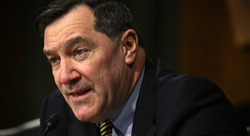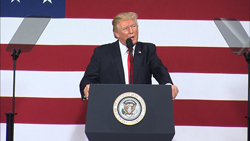President Trump traveled to Indianapolis to promote his proposal of reforming the American tax system in order to lower the tax rate from 35 percent to 25 percent on Wednesday, September 20.
Trump has long been advocating for reforming the American tax system.
The president’s speech took place at the Indiana State Fairgrounds at around 3:30 p.m., where he explained his tax reform plan, which many still considered to be vague, according to The Oakland Press.
“To protect millions of small businesses and the American farmer, we are finally ending the crushing, the horrible, the unfair estate tax, or as it is often referred to, the death tax,” Trump said during his speech.
“Today, our total business tax rate is 60 percent higher than our average foreign competitor in the developed world,” he continued.
The president traveled to the city due to the fact that winning the bipartisan support for a tax bill is receiving the support from Democrat Sen. Joe Donnelly, since he proves to cross party lines more often than other democrats.
Trump’s first significant speech on his tax reform proposal occurred in Missouri in August. He and Pence also visited North Dakota and West Virginia, respectively.
The trip was Trump’s second since he won the presidential election.
Currently, there are seven federal-income tax brackets, and the president wants to bring that down to three: 12%, 25%, and 35%. He states that by doing this, it will stimulate the economy. This was accomplished by former-President Ronald Raegan during the 1980s. Many today still advocate for Raegan-like tax cuts: “As someone who believes in capitalism, I think that the economy will improve with tax cuts to corporations and high-earning individuals,” Alexis Borrino, a sophomore primary-education major at Monmouth, stated.
 “I believe the cuts will serve to increase expansion of corporations, creating more jobs, which in turn will corporate earnings and spending and make its way down to lower income earners,” Borrino added. Additionally, Greg Laurinavicius, a senior political science major at Monmouth, aptly stated, “As long as it lowers my taxes, I’m happy.”
“I believe the cuts will serve to increase expansion of corporations, creating more jobs, which in turn will corporate earnings and spending and make its way down to lower income earners,” Borrino added. Additionally, Greg Laurinavicius, a senior political science major at Monmouth, aptly stated, “As long as it lowers my taxes, I’m happy.”
One of the most revered aspects of this plan is that of its corporate-tax reform. However, the problem is how polarized the current Congress is. Therefore, the likelihood of such a bill passing is unpredictable. On the other hand, there is no doubt that the current tax system needs refinement. “[The current tax law] is terribly complicated, abused, and misunderstood,” Professor Stives, an accounting professor at Monmouth University, says, “Most people don’t understand that corporate profits are taxed twice under our present system which ends up costing corporate shareholders more than 50 percent tax on complete income.”
Moreover, he explains that in order to evade such taxation, many U.S. corporations have invested in foreign countries: “[Corporations such as] Apple have incorporated in foreign countries such as the Netherlands and Ireland where taxes are a fraction of what we pay here,” Stives explains.
In contrast, Professor Christakos, a specialist in tax preparation, explains that lowering the taxes on the corporations may not work the way it is intended to, considering there are no provisions requiring the businesses to invest in specific areas to gain the tax deductions to create those savings. Instead, he says, “If the goal is specifically to put Americans back to work a better course of action may be to increase the tax effectiveness of investing in people, [such as additional tax credits for hiring people] as opposed to lowering the tax rate and allowing companies and their owners make their own investment decisions.”
The plan also eliminates the Estate tax and the Alternative Minimum tax; and no federal income tax would be levied against individuals earning $25,000 or less—or married couples earning $50,000 or less—according to the Tax Policy Center.
IMAGE TAKEN from grahamdigital.com
IMAGE TAKEN from politico.com


